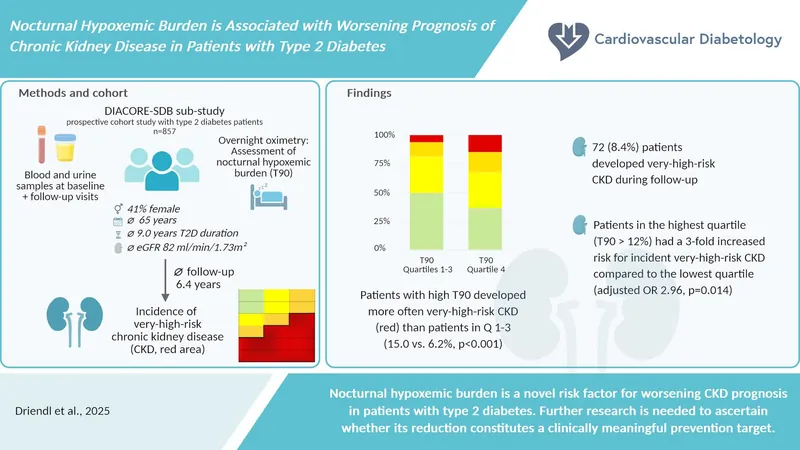
Unveiling the Hidden Dangers: HIV, Comorbidities, and Adverse Birth Outcomes in South African Pregnant Women
2025-09-02
Author: Arjun
The Rising Challenge of Non-Communicable Diseases in Pregnancy
In recent years, urbanization and changing diets across the globe have significantly increased body mass index (BMI) levels, leading to a surge in non-communicable diseases (NCDs) such as obesity, hypertension, and diabetes mellitus (DM). Alarmingly, in South Africa, nearly 68% of women aged 15 and above are overweight or obese. This unhealthy trend poses severe risks during pregnancy, with conditions like gestational weight gain linked to long-term obesity.
HIV: A Compounding Factor
For women living with HIV (WHIV), these risks are magnified. While antiretroviral therapy (ART) has improved survival rates, WHIV still face a shorter life expectancy due to heightened susceptibility to NCDs. Studies indicate that the rate of diabetes among WHIV is approximately 3.19% higher than in the general population, particularly during pregnancy. In Zambia, for instance, pregnant women on ART exhibited a higher incidence of gestational hypertension compared to their non-HIV peers.
A Critical Study in Cape Town
To probe deeper into these overlapping health challenges, researchers in Cape Town conducted a prospective cohort study. This research focused on comparing the prevalence of obesity, diabetes, and hypertension among pregnant women, both with and without HIV. The findings seek to uncover how these factors are associated with adverse birth outcomes.
Study Methodology and Key Findings
The study involved 989 participants, with 48% being WHIV. Preliminary analysis revealed an alarming prevalence of obesity (43%) and hypertension (15%) among participants. Despite a higher prevalence of NCDs among WHIV, results indicated no statistically significant differences in pre-existing health conditions compared to HIV-negative women. The study employed various assessment tools to gather data, emphasizing factors like socioeconomic status, substance use, and ART initiation timing.
The Unraveling Link to Adverse Birth Outcomes
Findings revealed that having comorbid conditions significantly exacerbated the risk of adverse birth outcomes. Pregnancies with WHIV and either hypertension or obesity showed elevated rates of preterm delivery (PTD) and low birth weight (LBW). Alarmingly, the risk of PTD was roughly three times higher in WHIV experiencing hypertension compared to those without any NCDs.
Insights on Maternal Health and Future Implications
This research highlights a crucial intersection of maternal health, especially amid increasing obesity rates and a significant HIV burden in low-middle-income countries. The coexistence of these factors suggests an urgent need for comprehensive healthcare strategies to address the compounded health risks that pregnant women face.
Protective vs. Risk Factors in Pregnancy Outcomes
Interestingly, results indicated that while hypertension significantly correlated with adverse outcomes, obesity appeared to offer some protective effects against SGA (small for gestational age) in WHIV pregnancies. This finding contradicts traditional beliefs that view obesity predominantly as a risk factor. It underscores the complex role of maternal weight in pregnancy, suggesting a balanced approach to managing both risks and benefits associated with maternal health.
Conclusions and Future Directions
Ultimately, this study provides a critical lens through which to view the intertwined challenges of HIV and NCDs in maternal health. As ART guidelines evolve, ongoing research is essential to assess the long-term impacts of treatment regimens on both NCD prevalence and maternal outcomes. It stands clear that addressing these intertwined health issues requires integrated care approaches tailored to the unique circumstances of women living with HIV.


 Brasil (PT)
Brasil (PT)
 Canada (EN)
Canada (EN)
 Chile (ES)
Chile (ES)
 Česko (CS)
Česko (CS)
 대한민국 (KO)
대한민국 (KO)
 España (ES)
España (ES)
 France (FR)
France (FR)
 Hong Kong (EN)
Hong Kong (EN)
 Italia (IT)
Italia (IT)
 日本 (JA)
日本 (JA)
 Magyarország (HU)
Magyarország (HU)
 Norge (NO)
Norge (NO)
 Polska (PL)
Polska (PL)
 Schweiz (DE)
Schweiz (DE)
 Singapore (EN)
Singapore (EN)
 Sverige (SV)
Sverige (SV)
 Suomi (FI)
Suomi (FI)
 Türkiye (TR)
Türkiye (TR)
 الإمارات العربية المتحدة (AR)
الإمارات العربية المتحدة (AR)